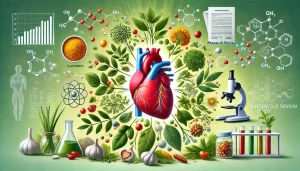Introduction: Cardiovascular diseases (CVDs) represent a significant global health challenge, responsible for high rates of morbidity and mortality. While conventional treatments such as pharmaceuticals and lifestyle modifications remain the cornerstone of therapy, interest in complementary and alternative medicine, particularly herbal treatments, has surged. This article aims to provide a comprehensive scientific review of the role of herbal treatments in cardiovascular health by delving into their mechanisms of action, efficacy, safety, and future prospects.
Background on Cardiovascular Diseases: Cardiovascular diseases encompass a range of conditions that affect the heart and blood vessels, including hypertension, atherosclerosis, coronary artery disease, and heart failure. Despite advancements in medical treatments, CVDs remain prevalent due to risk factors like poor diet, sedentary lifestyle, and genetic predisposition. Conventional treatments often involve medications such as statins, beta-blockers, and ACE inhibitors, alongside lifestyle changes. However, these treatments can have limitations, including side effects and variable efficacy. Consequently, there is an increasing interest in herbal treatments as adjunct therapies.
Mechanisms of Action for Herbal Treatments: Herbal treatments offer a plethora of bioactive compounds that can positively impact cardiovascular health through various mechanisms:
-
Anti-inflammatory Properties: Chronic inflammation is a significant contributor to the progression of cardiovascular diseases. Certain herbs exhibit potent anti-inflammatory effects, reducing markers of inflammation such as C-reactive protein (CRP) and interleukin-6 (IL-6).
-
Antioxidant Effects: Oxidative stress, resulting from an imbalance between free radicals and antioxidants, plays a critical role in the pathogenesis of CVDs. Herbal antioxidants neutralize free radicals, thereby preventing oxidative damage to lipids, proteins, and DNA.
-
Vasodilatory Actions: Herbs can promote vasodilation, improving blood flow and reducing blood pressure. This is often mediated through the release of nitric oxide (NO) from the endothelium.
-
Lipid-Lowering Capabilities: Certain herbal treatments can modulate lipid metabolism, reducing levels of low-density lipoprotein (LDL) cholesterol and triglycerides while increasing high-density lipoprotein (HDL) cholesterol.
Evidence-Based Herbal Treatments: Several herbs have garnered scientific attention for their cardiovascular benefits:
-
Garlic (Allium sativum): Garlic contains sulfur-containing compounds like allicin that exhibit antihypertensive, anti-atherosclerotic, and lipid-lowering effects. Clinical studies have demonstrated that garlic supplementation can reduce blood pressure and cholesterol levels. However, dosage and preparation methods (raw, aged extracts, supplements) are critical for its efficacy and safety.
-
Hawthorn (Crataegus spp.): Hawthorn berries and leaves are rich in flavonoids and oligomeric proanthocyanidins, which improve cardiac function by enhancing coronary blood flow and reducing peripheral resistance. Clinical trials have shown hawthorn’s efficacy in improving symptoms of heart failure and coronary artery disease. Safety studies indicate a favorable profile with minimal interactions.
-
Ginseng (Panax ginseng): Ginsenosides, the active components of ginseng, have been shown to possess cardioprotective properties, including reducing inflammation, improving endothelial function, and modulating lipid profiles. Research indicates that ginseng can lower blood pressure and improve lipid metabolism. Recommended usage varies, with Asian and American ginseng having distinct profiles and benefits.
-
Turmeric (Curcuma longa): The active compound curcumin in turmeric exerts significant anti-inflammatory and antioxidant effects. Clinical evidence supports turmeric’s role in reducing arterial plaque buildup and improving endothelial function. Usage recommendations focus on curcumin supplements to enhance bioavailability.
-
Gingko Biloba: Gingko biloba improves blood circulation and protects against oxidative stress and inflammation. Studies have highlighted its benefits in improving peripheral vascular disease symptoms and preventing stroke. However, potential interactions with anticoagulants necessitate cautious use.
Comparative Analysis with Conventional Treatments: Herbal treatments offer several benefits, such as fewer side effects and holistic health improvements. However, variability in active compounds and lack of standardization can limit their effectiveness compared to conventional medications. Certain conditions, like severe hypertension or advanced heart failure, may still necessitate conventional treatments, with herbal treatments serving as complementary options.
Safety, Interactions, and Regulatory Issues: Herbal treatments pose risks related to adverse effects and interactions with conventional medications. Quality control is essential to ensure consistency and safety. Regulatory frameworks vary, with some regions having stringent guidelines while others lack comprehensive regulations.
Future Directions and Research Needs: Emerging research highlights numerous potential herbs for cardiovascular health, but comprehensive clinical trials are needed to substantiate these findings. Personalized herbal medicine, considering genetic and environmental factors, holds promise for optimizing cardiovascular care.
Conclusion: Herbal treatments offer a compelling adjunct to conventional cardiovascular therapies, providing anti-inflammatory, antioxidant, vasodilatory, and lipid-lowering benefits. Integrating evidence-based herbal treatments into cardiovascular care, alongside conventional methods, can enhance patient outcomes. Rigorous research and standardization are essential to maximize the potential of herbal treatments in cardiology.
References:
- Zeng, T., Guo, F. F., Zhang, C. L., Zhao, X. L., Zhang, C., & Peng, W. J. (2015). A meta-analysis of randomized, double-blind, placebo-controlled trials for the effects of garlic on serum lipid profiles. Journal of the Science of Food and Agriculture, 95(4), 867-908.
- Walker, A. F., Marakis, G., Simpson, E., & Hope, J. L. (2002). Hypotensive effects of hawthorn for patients with diabetes taking prescription medications: a randomised controlled pilot study. British Journal of General Practice, 52(482), 946-951.
- Buettner, C., Yeh, G. Y., Phillips, R. S., Mittleman, M. A., & Kaptchuk, T. J. (2006). Systematic review of the effects of ginseng on cardiovascular risk factors. Annals of Pharmacotherapy, 40(1), 83-95.
- Kunnumakkara, A. B., Bordoloi, D., Harsha, C., Banik, K., Gupta, S. C., & Aggarwal, B. B. (2017). Curcumin mediates anticancer effects by modulating multiple cell signaling pathways. Clinical Science, 131(15), 1781-1799.
- Mahady, G. B. (2001). Ginkgo biloba for the prevention and treatment of cardiovascular disease: a review of the literature. Journal of Cardiovascular Pharmacology, 38(5), 601-609.

